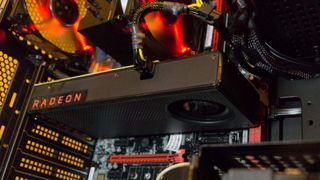AMD’s RX 480 graphics card can be turbocharged to RX 580 levels
But flashing the BIOS is a dangerous undertaking

Want to juice up your Radeon RX 480 graphics card so it’s as powerful as one of AMD’s new RX 580 offerings? Some enterprising folks have apparently achieved this ‘free upgrade’ feat already by flashing the older card with the freshly released firmware from an RX 580 – but be warned, this is certainly not an undertaking for the fainthearted.
The process was performed by a denizen of the TechPowerUp forums known as TonybonJoby (let’s call him Tony for short), who employed the ATIFlash utility to use the BIOS from a Sapphire RX 580 in his XFX RX 480 graphics card.
Once flashed with the new firmware, the RX 480 ran fine at the (much faster) stock clock speed of the RX 580 (1411MHz), seeming to be ‘completely stable’ according to Tony, with no evidence of crashing or glitches (he mentions testing the flashed card with The Witcher 3: Wild Hunt, incidentally).
So why wouldn’t you want to do this? For starters, flashing a graphics card like this is a relatively tricky process that shouldn’t be attempted by those who aren’t tech-savvy and fully confident in what they’re doing. Making a mistake could easily brick your graphics card, rendering it a useless lump.
- Need better sound? These are the best PC gaming headsets
Longer game
Results will also vary depending on the exact card and firmware used, so there’s no guarantee this will work. And even if it does, apparent short-term stability is one thing, but you may run into problems in the longer run.
This is because the RX 480 is being pushed considerably beyond its clock limits, which were imposed by AMD for a good reason. So, while you’re getting faster performance, the graphics card will also be getting hotter than it should - which could be a definite issue longer-term.
Tony mentions his RX 480’s temperatures getting into the 80s once it had been flashed, and that’s a little too warm for comfort, particularly if it’s going to be running that way for any sort of prolonged period.
Get daily insight, inspiration and deals in your inbox
Get the hottest deals available in your inbox plus news, reviews, opinion, analysis and more from the TechRadar team.
And for all these reasons, we’d recommend you steer clear, but if you do want to give this a go, proceed with a great deal of caution, and it’s worth reading Tony’s own warnings right here. It’s also worth noting that he had dual BIOS settings in the XFX card used, meaning he had a fall-back option if something went wrong, and could theoretically recover.
Neowin, which spotted the development, also linked to a story about an RX 470 being flashed to an RX 570 – but that article has since been taken down. Again, this points to the potential dangers that lie in the veritable minefield of messing with the BIOS.
The safest way to get an RX 580 is, of course, to simply buy one. And if you’re mulling that prospect, check out our AMD RX 580 review in which we evaluate how this fresh AMD offering compares to Nvidia’s rival GTX 1060.
- Find out how the Surface Studio competes with these hardy graphics
Darren is a freelancer writing news and features for TechRadar (and occasionally T3) across a broad range of computing topics including CPUs, GPUs, various other hardware, VPNs, antivirus and more. He has written about tech for the best part of three decades, and writes books in his spare time (his debut novel - 'I Know What You Did Last Supper' - was published by Hachette UK in 2013).
Most Popular

